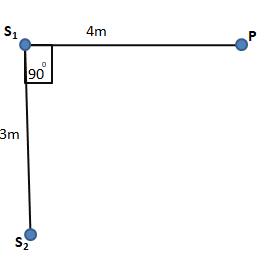Question
Question: If \({S_1}\) and \({S_2}\) are two coherent sources of the sound of frequency \[110Hz\] each. They h...
If S1 and S2 are two coherent sources of the sound of frequency 110Hz each. They have no initial phase difference. The intensity at a point P due to S1 is I0 and due to S2 is 4I0 . If the velocity of sound is 330m/s then the resultant intensity at P is
a. I0
b. 9I0
c. 3I0
d. 8I0

Solution
The frequency and velocity of the sound wave are given. Find the wavelength of the wave.
Use the information given in the diagram and find the path difference.
calculate the path difference by the path difference.
Use the intensity formula for two waves after interference and put the phase difference in this formula to get the resultant intensity.
Formula used:
The wavelength, λ=f(frequency)V(velocity of sound wave)
The path difference, x=S2P−S1P
The phase difference, ϕ=λ2πx
The resultant intensity after the interference of two waves, I=I1+I2+2I1I2cosϕ
I1,I2 are the intensities of the two waves.
Complete step by step answer:
S1 and S2 are the two coherent sources of the sound waves. The frequency of each wave is f=110Hz
After the interference of two waves of the intensities I1,I2 [I1=I0 and I2=4I0
], the resultant intensity will be,
I=I1+I2+2I1I2cosϕ , ϕ is the phase difference.
The phase difference can be described by, ϕ=λ2πx
Where, λ is The wavelength and x is The path difference.
λ=f(frequency)V(velocity of sound wave)=110330
∴λ=3m
The path difference, x=S2P−S1P
From the figure, S2P=42+32=5 [ since this is a right-angle triangle]
∴x=S2P−S1P=5−4=1m
∴ϕ=λ2πx=2π31=32π
Now, I=I1+I2+2I1I2cosϕ
I1=I0 and I2=4I0
cosϕ=cos32π=−21
∴I=I0+4I0+2I0×4I0(−21)
⇒I=5I0−I0×4I0
⇒I=5I0−2I0
⇒I=3I0
So the resultant intensity of the two waves after the interference, ⇒I=3I0
Hence, the correct answer is option (C).
Additional information:
• The coherent sources are most important for interference.
• When the two waves of the same wavelengths and same frequency superpose, interference occurs.
• The phase difference of the two waves for which the interference occurs should be constant.
Note: The relation between the intensity and the amplitude will be, I∝A2.
Let, the amplitudes of the two waves are A1 and A2, and the phase difference is ϕ.
If the two waves are superposed, the resultant amplitude A=A12+A22+2A1A2cosϕ.
